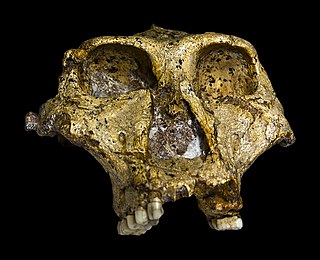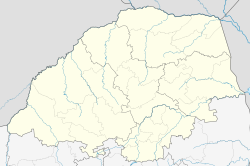
The Ditsong National Museum of Natural History, formerly the Transvaal Museum, is a natural history museum situated in Pretoria, South Africa. It is located on Paul Kruger Street, between Visagie and Minnaar Streets, opposite the Pretoria City Hall. The museum was established in 1895 by the former South African Republic, also known as the Transvaal. In 2010 it was one of the founding Museums of Ditsong Museums of South Africa.

The Cradle of Humankind is a paleoanthropological site about 50 km (31 mi) northwest of Johannesburg, South Africa, in the Gauteng province. Declared a World Heritage site by UNESCO in 1999, the site currently occupies 47,000 hectares (180 sq mi) and contains a complex of limestone caves. The registered name of the site in the list of World Heritage sites is Fossil Hominid Sites of South Africa.

Botshabelo, meaning "a place of refuge", is a large township set up in 1979 by the then apartheid government 45 km east of Bloemfontein in the present-day Free State province of South Africa. Botshabelo situated on the N8 road road and it was once the second-largest township in South Africa. The population comprises mainly people who speak Southern Sotho and Xhosa. The township had over 350 000 inhabitants as of the 2001 census.

Paranthropus robustus is an early hominin, originally discovered in Southern Africa in 1938. Particularly regarding cranial features, the development of P. robustus seemed to be in the direction of a "heavy-chewing complex". On account of the definitive traits associated with this "robust" line of australopithecine, anthropologist Robert Broom established the genus Paranthropus and placed this species in it.

TM 1517 is a fossilized skull and lower mandible of the species Paranthropus robustus. It was discovered at Kromdraai, South Africa in 1938 by Robert Broom.

The Wonder Cave, in Kromdraai, Gauteng, South Africa, is the third-largest cave chamber in the country, and is believed to be about 2.2 billion years old. The single chamber has an area of 46,000 square metres (500,000 sq ft), and is 125 by 154 metres.

Kromdraai Conservancy is a protected conservation park located to the south-west of Gauteng province in north-east South Africa. It is in the Muldersdrift area not far from Krugersdorp.

Cooper's Cave is a series of fossil-bearing breccia filled cavities. The cave is located almost exactly between the well known South African hominid-bearing sites of Sterkfontein and Kromdraai and about 40 kilometres (25 mi) northwest of Johannesburg, South Africa and has been declared a South African National Heritage Site.

Motsetsi Cave is a fossil-bearing breccia filled cavity located about 14 kilometres (8.7 mi) east of the well known South African hominid-bearing sites of Sterkfontein and Kromdraai and about 45 kilometres (28 mi) north-northwest of Johannesburg, South Africa. Motsetsi has been declared a South African National Heritage Site.

Plovers Lake Cave is a fossil-bearing breccia filled cavity in South Africa. The cave is located about 4 km Southeast of the well known South African hominid-bearing sites of Sterkfontein and Kromdraai and about 36 km Northwest of the City of Johannesburg, South Africa. Plovers Lake has been declared a South African National Heritage Site.

Kromdraai is a fossil-bearing breccia-filled cave located about 2 kilometres (1.2 mi) east of the well-known South African hominid-bearing site of Sterkfontein and about 45 kilometres (28 mi) northwest of Johannesburg, South Africa. It is situated within the Cradle of Humankind World Heritage Site and is itself a South African National Heritage Site.
Wonder Cave may refer to:

Section 27 of the National Heritage Resources Act (NHRA) of South Africa provides for places of historic or cultural importance to be designated national heritage sites. This came into effect with the introduction of the Act on 1 April 2000, when all former national monuments declared by the former National Monuments Council and its predecessors became provincial heritage sites as provided for in Section 58 of the Act.
Gorgopithecus is an extinct genus of primate, in the old word monkey family Cercopithecidae, closely related to the baboons. There is only one known species, Gorgopithecus major. It has been found at sites from the early Pleistocene Epoch in South Africa and Tanzania. It was first discovered at the Kromdraai A site in South Africa. It has since been found from Swartkrans, South Africa. Most recently, it has been recognized from the DKI site in Bed I of Olduvai Gorge, Tanzania, which has been dated to 1.8 million years old.

Tlokwe Local Municipality was a local municipality in Dr Kenneth Kaunda District Municipality, North West Province, South Africa. The seat was Potchefstroom. After the municipal elections on 3 August 2016 it was merged into the larger JB Marks Local Municipality.

The Amcoal Class E38 of 1993 is a South African industrial electric locomotive.

Muldersdrift, in the Gauteng Province of South Africa, is a picturesque rural area situated 27 km north-west of the CBD between Johannesburg and the Magaliesberg mountain range. The area falls under the West Rand District Municipality, and is part of Mogale City.
John Talbot Robinson was a distinguished South African hominin paleontologist. His most famous discovery was the nearly complete fossil skull of the hominin species Australopithecus africanus, known as Mrs. Ples.
















